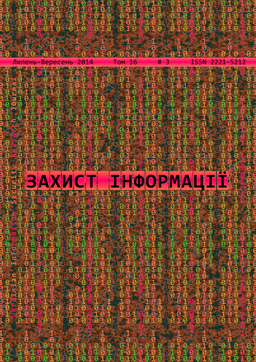Phase detection method embedded devices in telephone line
DOI:
https://doi.org/10.18372/2410-7840.16.7542Keywords:
unauthorized connection, the subscriber telephone line, line adapter, fourshoulder bridge AC phase comparatorAbstract
Interception of telephone communications and listening rooms equipped with telephones is the most likely threats to information security telecommunication subscribers. Although developed many methods and identify telephonebugs, but given the development of information technology, the search for new methods of detecting unauthorized connections to ATL. Design and investigate of linear bridge adapter for detecting unauthorized connectionsto telephone lines is described in this article. Ablock diagram of device for implementing the phase detection method of telephone bags is shown. A mathematical model of the linear adapter is developed and an efficiencyof its operations is analyzed. The synchronousdetection using for increasing of the device noise immunityis augmented.References
. Блінцов В.С. Концепція створення лабораторного комплексу «Основи технічного захисту інформації в ВТКМ» // Блінцов В.С., Нужний С.М.,nБаша Д.А. // Матеріали Х Міжнародної науково-
технічної конференції «Авіа-2011». - Т.1. - К.: НАУ, 2011. - С.248-251.
. Джонсон Г., Грехем М. Високошвидкісна передача цифрових даних: вищий курс чорної магії: Пер. з англ. - М.: Видавничий дім «Вільямс», 2005 - 1024с.
. Дорожовець М. Основи метрології та вимірювальної техніки: Підручник: У 2 т. /Дорожовець М., Мотало В., Стадник Б., Василюк В., Борек Р., Ковальчик А.; за ред. Б.Стадника. - Львів: Вид-во НУ "Львівська політехніка", 2005. - Т.2. Вимірювальна техніка. - 656 с.
. Дудикевич В.Б. Захист засобів і каналів телефонного зв'язку: навч. посібник / Дудикевич В.Б., Хома В.В., Пархуць Л.Т. - Львів: Видавництво Львівської політехніки, 2012. - 212 с.
. Готра З. Завадостійкій сигнальний перетворювач на базі синхронного детектора // Вимірювальна техніка та метрологія. - № 71, 2010, с.110-116.
. Карпов І.В., Нужний С.М. Математичне моделювання відкритих телекомунікаційніх електропровідніх ліній для задач технічного захисту інформації // Матеріали ІI Всеукраїнської науково- технічної конференції з міжнародною участю
. Лєнков С.В. Методи і засоби захисту інформації. У 2-х томах / Лєнков С.В., Перегудов Д.А., Хорошко В.О. Під ред. В.А.Хорошко. - К.: Арій, 2008. - Том І. Несанкціоноване отримання інфо-
рмації. - 464 с.
. Місюра С.М. Варіант захисту мовної інформації на об'єктах інформаційної діяльності // Місюра С.М., Овсянніков В.В., Мальцева І.Р.// Збірник наукових праць ВІТІ НТУУ "КПІ" № 2 - 2011, с. 84-93.
. Свінцов І.В. Фазовий метод виявлення несанкціонованого підключення до слабострумових лінії зв'язку// Свінцов І.В., Проталинский О.М., Свінцов В.Я // Датчики і системи. 2009. № 7. С. 2-4.
. Хома В.В. Методи і засоби технічного захисту інформації на абонентських телефонних лініях. / В.В. Хома // Автоматика, вимірювання та керування № 639. - Л.: Вид-во Нац. ун-ту "Львів. політехніка", 2009. - С. 87-93.
. Хорєв А.А. Класифікація електронних пристроїв перехоплення інформації // Спецтехніка і зв'язок. - 2009. - № 1. - С. 46-49.
Downloads
Published
Issue
Section
License
Authors who publish with this journal agree to the following terms:- Authors retain copyright and grant the journal right of first publication with the work simultaneously licensed under a Creative Commons Attribution License that allows others to share the work with an acknowledgement of the work's authorship and initial publication in this journal.
- Authors are able to enter into separate, additional contractual arrangements for the non-exclusive distribution of the journal's published version of the work (e.g., post it to an institutional repository or publish it in a book), with an acknowledgement of its initial publication in this journal.
- Authors are permitted and encouraged to post their work online (e.g., in institutional repositories or on their website) prior to and during the submission process, as it can lead to productive exchanges, as well as earlier and greater citation of published work (See The Effect of Open Access).

